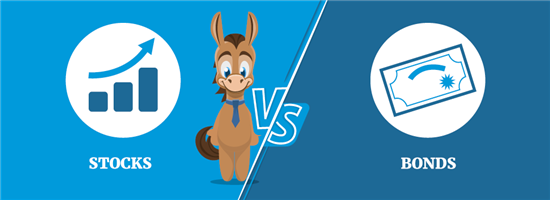Difference Between Stocks and Bonds
Stocks are riskier with potentially higher returns, while bonds are more predictable. A good investment strategy includes a mix of both. Read on to learn more.
Stocks and Bonds
 |
You do not need a degree in finance to understand investing. But it does help to understand the difference between stocks and bonds.
In this article, we help you break down the differences. We also help you understand where and when you should invest in each. You can take the concepts as they apply to your life and start your investment portfolio.
Do You Want Ownership or Debt?
 |
Breaking stocks and bonds down is as easy as understanding the difference between ownership and debt.
Purchasing a company's stock helps the company get the cash they need to build their business. Offering shares allows businesses to avoid taking on new debt. They receive cash in exchange for the shares. They then use the cash to help their business flourish. When you buy a share, you own a "piece" of the company. The shares may go up or down in value.
You want to invest in stocks only when you are in it for the long run. You need the time to wait out the downturns the stock may take. The price of the shares fluctuates based on the company's performance. Companies doing poorly have plummeting stocks while those doing well have rising stock prices.
Bonds are a company's debt. You become the "lender" to the company. When you purchase a bond, the company takes the cash for operations or building it up. In exchange, you receive a bond. The bond has a specific interest rate and maturity date. The company must pay you the appropriate amount by the maturity date. Bonds have specific terms to understand:
- Face value - The amount you pay for the bond.
- Coupon rate - The interest rate the company agrees to pay you.
- Maturity - The length of time the company has to pay back the face value of the loan.
You buy a bond for $1,500; this is the face value. It has a coupon rate of 2% and matures in 5 years. For the next five years you would receive $30 in interest each year. If you have a semi-annual coupon rate, you would receive $15 twice per year. After five years, you would receive the face value of $1,500 back from the company.
Equation You Can Use: Determine the return on your bond investment: Face value x Coupon rate = Annual return on investment
Bonds are predictable. You can calculate the return on your investment before you purchase one. Stocks, on the other hand, are volatile with no chance for prediction.
Stocks Are Volatile
Stocks depend on many factors, including the company's performance and supply and demand for the stock.
- Stocks in high demand have higher prices.
- Stocks lower in demand have lower prices.
Investors figure in their thoughts and feelings on a company's performance at any given time as well. These factors add up to create the fluctuating stock prices.
Buying stocks means you make money when the company performs well. It also means you lose money when the company performs poorly. It is not as black and white as it seems, though. Many factors influence a stock price. For example, if there was a large recall on a company's products, chances are its stock plummets temporarily. A few weeks or months later, however, it could pick up again.
Note that the bigger question is how to protect your capital from the hidden enemy—inflation, which reduces the value of your investments. Most folks forget about this important element of investing.
Michael Osteen, founder and chief investment strategist, Port Wren Capital LLC
Waiting out a stock's ups and downs usually results in a larger return than bonds offer. Investing in stocks should be a long-term investment. This way you can ride out the ups and downs and hopefully come out on top.
The performance of stocks depends on how the company is doing and the supply and demand, so the price can fluctuate more. However, historically, stocks have higher returns over the long-term.
Bonds Carry Risk
Bonds are not without risk either, though.
- If interest rates fall, bonds suffer.
- When interest rates increase, bond prices fall. Bonds then trade at a discount to accommodate the lower return.
Other risks bonds pose include:
- Reinvestment Risk - If interest rates fall and the bond is called (i.e., redeemed prior to its maturity date), you run the risk of reinvesting that money at a lower rate than what you had on that bond.
- Call Risk - Certain bonds have a "call provision." This allows the issuer to pay the bond off prematurely. Issuers typically do this when interest rates fall. The issuer pays the debt off and sells it to a new investor at the lower interest rate.
- Interest Rate Risk - If interest rates rise, any bonds you currently own lose value (for example, if you own a bond with a 3% interest rate and rates increase to 5%). A new investor can purchase a bond at 5%. Selling your 3% bond will be difficult, causing its value to fall.
Keep in mind that bonds typically trade on the secondary market. You do not purchase them straight from the issuer. Instead, you purchase them from someone selling the bonds on the secondary market. When bonds sell in the market, they usually sell at a discount. The changing interest rates we discussed above affect a bond's value. This affects how much they sell for in the market.
In easy-to-understand terms, if the current interest rates exceed the bond's coupon value, it sells at a discount.
Asset Allocation or Diversification
A smart investor diversifies his portfolio. He also has a strategy to further his savings. Every investor's portfolio will look different, though. There is no right way for everyone.
Bonds provide you with a "lower risk" investment. You know your rate of return if you keep the bond. However, selling it on the secondary market may require you to sell for a discount. Stocks have an even higher risk. If you need your money, you have to sell at the current market price. You cannot predict what the market value will be at any given time.
You likely heard the term "don't put all your eggs in one basket." In investing terms, this means do not put all your money in one stock.
If you invest in the stock market, choose several stocks. You can use an index, such as the S&P 500, to help guide you to the larger and more stable stocks. Again, you cannot predict how any stock will do, so even a stock on the S&P 500 can plummet unexpectedly. If you put your money into different stocks, though, you may lose money on one stock, but make it back on another one.
If you want a solid investment strategy, you need a solid risk management system. However, understand you cannot ever escape risk. History can repeat itself and every asset across the board can plummet unexpectedly. Investing in high and low risk investments all at once minimizes the overall risk of your portfolio.
What Is Your Timeframe?
Figuring out your timeframe will help determine the right investment strategy for you.
For example, a 30-year-old has a much different investment strategy than a 60-year-old. The 30-year-old still has many more years before retirement. He can handle more risks than a 60-year-old who may need his money for daily living right now. A 30-year-old who loses it all still has time to make it back. If a 60-year-old lost it all, it could financially devastate him.
Leif Kristjansen, blogger, FiveYearFIREescape.com
Generally, at age 50, taking fewer risks with your money is the better choice. This does not mean you have to stick to bonds and savings accounts at age 50. You need to change your investment strategy instead. Let's say you invested 70% of your money in stocks and 30% in bonds and money markets. At age 50, you may want to decrease the money you invest in stocks and increase the money in bonds.
Here is a simple equation to use as a guideline to help you figure out your asset allocation:
Men: 110 - your age = Percentage of your funds you should invest in stocks
Women: 120 - your age = Percentage of your funds you should invest in stocks
Men and women have different ratios because women have a higher life expectancy. This gives them a little more time to invest in "risky investments."
If you take a 40-year-old man and woman, it would look like this:
Men: 110 - 40 = 70% of a portfolio invested in stocks
Women: 120 - 40 = 80% of a portfolio invested in stocks
This pertains to investors with a long-term strategy. Before you determine the right asset allocation for you, determine your long-term goals.
What are you investing for? Is it for retirement in 30 years or to purchase a house in 5 years? Each situation has a very different investment strategy. A person with a very long-term goal (20 years) can invest in stocks without too much risk. Someone with a shorter goal (5-10 years) should diversify more, including bonds and stock market investments. If you have an immediate need for the funds (2-5 years), sticking with a majority of short-term bond investments is best.
Think About Your Goals
Determining the right asset allocation strategy requires many factors.
Start by writing down your goals. Are they long-term or short-term goals? If you have mostly short-term goals, you need stable investments. Long-term goals (mainly retirement money) allow for more flexibility.
Think about it larger terms - what would happen if you lost 20-30% of your investment? Could you survive? Would you have the time to wait it out for the market to recoup? If you could not handle a large loss, investing in stable options is better.
For most people, a good combination of risky and less risky investments works best. However, there are special circumstances. Consider how much money you need and your timeframe to obtain it. For example, if you do not have any retirement savings yet, you may need an aggressive strategy. If you regularly make retirement contributions, though, a good allocation of stocks and bonds will likely suffice.
Your Next Step
If you are ready to invest, start writing down your goals. What do you need the money for? When do you need it? These answers can help you get started on your investment strategy.
If you want to keep your risk lower, bonds are a good choice. However, if you want to make more money or take a higher risk, stocks often offer a better return. Determine your perfect strategy and start investing. The sooner you start, the more time you have to see a greater return on your investment.
Write to Kim P at feedback@creditdonkey.com. Follow us on Twitter and Facebook for our latest posts.
Note: This website is made possible through financial relationships with some of the products and services mentioned on this site. We may receive compensation if you shop through links in our content. You do not have to use our links, but you help support CreditDonkey if you do.
Read Next:






